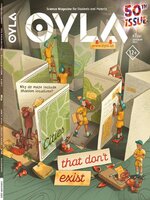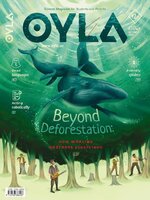OYLA Magazine is a science and technology publication for readers aged 12 and up. It features engaging articles, interactive content, and stunning visuals designed to inspire curiosity and a love for learning. Ideal for young minds eager to explore and understand the world around them.
OYLA Magazine
Regular Polygons • A square, an equilateral triangle, a regular hexagon, and a regular octagon are all examples of regular polygons. To create such shapes from an ordinary sheet of paper, you'd usually reach for a ruler, a compass, or a protractor. But what if we told you that you don't even need a pencil? Don't believe it? Then grab some paper and scissors, and let's find out!
Chat Like Spies: THE POLYBIUS SQUARE • It's never fun when someone snoops through your private messages or personal diary! But don't worry—you're not alone. Julius Caesar, medieval spies, and even 20th-century soldiers faced the same problem. Let's level up your note-taking, sharpen your cryptography skills, and learn a few fascinating historical tidbits along the way.
Faster than Light? • Truth, like art and beauty, demands sacrifice as well. Scientists often have to let go of familiar concepts and long-standing principles. One such “sacrifice” was the principle of action at a distance—a notion once considered obsolete alongside the caloric theory and the geocentric model. Yet, this principle has made a surprising comeback.
NANO BEACH
STARS OF THE UNDERWATER KINGDOM • The depths of the sea hide ruthless predators that give their victims no chance to escape. These creatures can regrow their entire bodies from just a small piece and move around using a unique hydraulic system. No, these are not mysterious sea monsters—they are none other than the harmless-looking starfish.
TECHNOLOGIES AND and RESETTLEMENT • By around 10,000 years ago, humans had settled nearly all land on Earth, with the exception of Antarctica and the most remote islands. However, since then, large-scale migrations have occurred more than once. What drove our ancestors to keep moving?
DO ANIMALS HAVE Emotions? • We smile with joy, freeze in fear, and show empathy to others. But what about animals? When a cat arches its back or a dog lowers its ears in guilt, are they actually experiencing emotions similar to ours?
REPAIRING DINOSAURS • Paleontologists study the fossilized remains of extinct organisms. These can include footprints, imprints of skin or leaves, and even fossilized dung! However, the most awe-inspiring finds are undoubtedly the bones. It is the majestic skeletons of dinosaurs and mammoths that draw the most attention in paleontological museums.
HOW PLANTS COMMUNICATE • For a long time, people had no idea that plants could exchange signals with one another. But it turns out our green companions use some of the very same means of communication we do—including hormones and electrical impulses.
GREEN LIGHT
SUSTAINING ecoSYSTEMS • Before agriculture came on the scene, humans depended on nature for their sustenance. Agriculture has allowed us to produce our own food, but ecosystems are just as critical as they have always been. How can we use their bounty to benefit humanity without exhausting them?
QUANTUM COMPUTERS: The Superpowers of Superposition • The growth of computational power in traditional computers has its limits. After all, the number of transistors that can fit on an integrated circuit chip cannot increase forever. But what if we could build a machine that performs calculations not with electrical currents, but by leveraging the strange and fascinating rules of quantum mechanics?
THE “EYE” of Jupiter • For almost two centuries now, astronomers have been observing Jupiter's Great Red Spot—one of the largest anticyclones in the Solar System. What exactly is this giant storm? How did it...

 July 2025 #56
July 2025 #56
 June 2025 #55
June 2025 #55
 May 2025 #54
May 2025 #54
 April 2025 #53
April 2025 #53
 March 2025 #52
March 2025 #52
 February 2025 #51
February 2025 #51
 January 2025 #50
January 2025 #50
 December 2024 #49
December 2024 #49
 November 2024 #48
November 2024 #48
 October 2024 #47
October 2024 #47
 September 2024 #46
September 2024 #46
 August 2024 #45
August 2024 #45